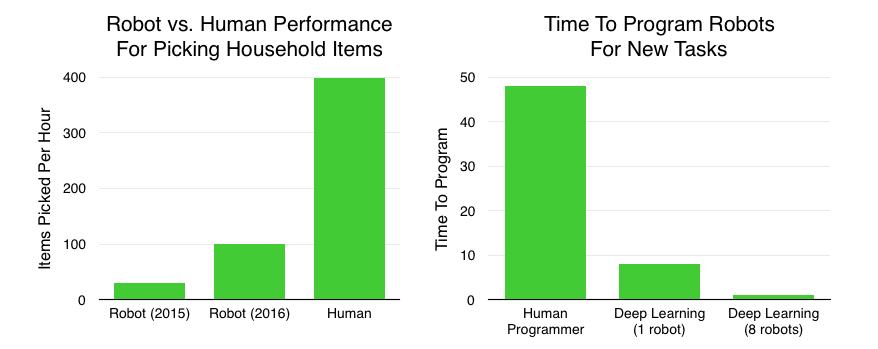Could Deep Learning Grow the Robotics Market Ten-Fold (or More)?

Deep learning—a machine learning algorithm that is setting performance records in vision, speech, medical diagnosis, and other fields [1]—could have a profound impact on the robotics industry. Despite their widespread use in manufacturing, robots are expensive and difficult to program. For most businesses, robots are not useful, at least not yet.
In 2015, global unit sales of industrial robots were only ~250,000, though in perspective roughly tenfold the number of mainframe computers at their peak.[2] By comparison, last year server and PC units sold totaled ~10 million and ~300 million units, respectively.[3] Clearly, robotics is at a nascent stage, calling for dramatic improvements in both cost and ease of use before it proliferates.
Robots are driving down the proverbial cost curve. ARK estimates that the cost of industrial robots will be cut in half to roughly $100,000 during the next ten years. Concurrently, a new breed of robots designed to co-operate with humans will hit roughly $30,000. Today retail assistant robots like SoftBank’s Pepper cost roughly $10,000, including service fees. Safer and more agile, this new breed of robots doesn’t require safety cages, heavy duty fixtures, or expert programming. According to ABB Robotics, setup steps account for a third of the total cost of ownership (TCO) for industrial robots. As robot manufacturers incorporate more components from the electronics industry (such as cameras, processors, and sensors) we think industrial robot costs should approach those of consumer electronics.
Ease of use in the industrial robot space could be a more difficult hurdle to overcome than costs. Industrial robots require precise programming using industrial control systems, with each task broken down into a series of movements and six dimensions. Having no ability to learn from experience, these robots depend on new programs to preform new tasks, limiting the market to industrial applications with predictable and well-defined tasks.
Deep learning, however, has been transformative, turning robots into learning machines. Instead of precise programming, robots learn over time from both data and experience, and can perform a wide variety of tasks. ARK believes that at some point, a warehouse robot capable of picking any item from a shelf and placing it in a box will be a boon to many businesses. Yet, without recent deep learning breakthroughs, recognizing and grasping objects in an infinite variety of shapes and sizes would not have been deemed possible.
In the Amazon [AMZN] Picking Challenge, a robotics competition, robots with camera based vision attempt to pick random items from a shelf and place them in a box. Between 2015 and 2016, the winning robot’s performance more than tripled from 30 to 100 items per hour. Both the first and second place teams in 2016 used deep learning as the core algorithm behind vision and grasping. At the recent rate of improvement, robots will surpass humans in picking more items per hour accurately within two years, as shown below.
 Source: Amazon, Preferred Networks
Source: Amazon, Preferred Networks
ARK believes that deep learning is a far more effective way to program robots to perform simpler, more predictable tasks. According to Preferred Networks, a private robotics company, deep learning enables a robot to learn a task in about eight hours, instead of the multiple days it would take a human programmer to teach a robot the same task, as shown above. When eight robots jointly learned the task, training time was reduced to one hour. Thus, deep learning is likely able to train a single robot five times faster than a human programmer, and with parallel training can improve performance by more than an order of magnitude.
Robots that combine cameras with computer vision are often cheaper to deploy than conventional robots. Because conventional robots can’t “see”, workloads must be laid out precisely, often with supporting hardware such as fixtures. Robots with vision use software and can adapt to changing workloads, instead of workloads adapting to the robot. They also can be reprogrammed rapidly for new tasks that otherwise would require costly physical rearrangements.
Robot heavyweights have taken notice. In 2015, Fanuc, a leading manufacturing of industrial robots, acquired a 6% stake in Preferred Networks and plans to ship deep learning enabled robots in the not-to-distant future. ABB Robotics, a Swiss company, also has invested in Vicarious, an AI startup with deep learning expertise.
Deep learning has the potential to expand the addressable market for robots dramatically, while traditional industrial robots are locked up in safety cages and perform highly programmed, repetitive work. Co-operative robots, powered by deep learning, should be able to operate in a wide variety of settings. As they learn new tasks on the job and work safely alongside humans, we think the robotics market will open up to small and medium sized businesses in retail and agriculture, not to mention homes as well.
While we believe industrial robots will remain the workhorse in high volume manufacturing, their unit volumes will be dwarfed by newer, nimbler robots, just as mainframe computers were dwarfed by workstations, PCs, and ultimately smartphones. As a result, robot shipments should multiply by 10 to 100 fold. Many of these new robots may not bear any resemblance to today’s robots, just as smartphones don’t resemble mainframes but now dominate the computing landscape. Powered by deep learning, we believe smaller smarter robots will take over.

 Actively Managed Equity
Actively Managed Equity Overview: All Strategies
Overview: All Strategies Investor Resources
Investor Resources Indexed Equity
Indexed Equity Private Equity
Private Equity Digital Assets
Digital Assets Invest In The Future Today
Invest In The Future Today
 Take Advantage Of Market Inefficiencies
Take Advantage Of Market Inefficiencies
 Make The World A Better Place
Make The World A Better Place
 Articles
Articles Podcasts
Podcasts White Papers
White Papers Newsletters
Newsletters Videos
Videos Big Ideas 2024
Big Ideas 2024


